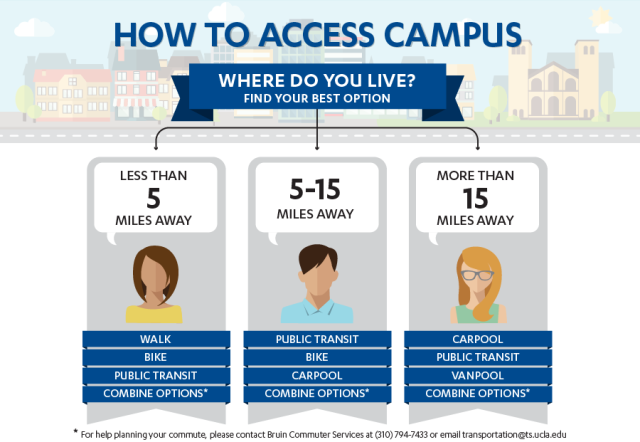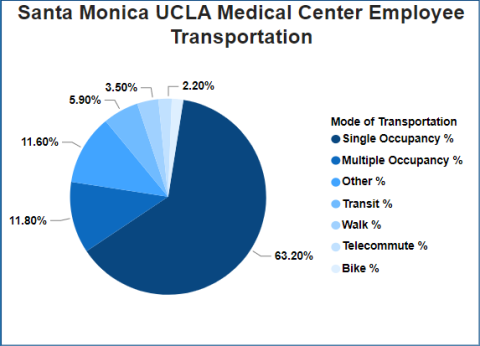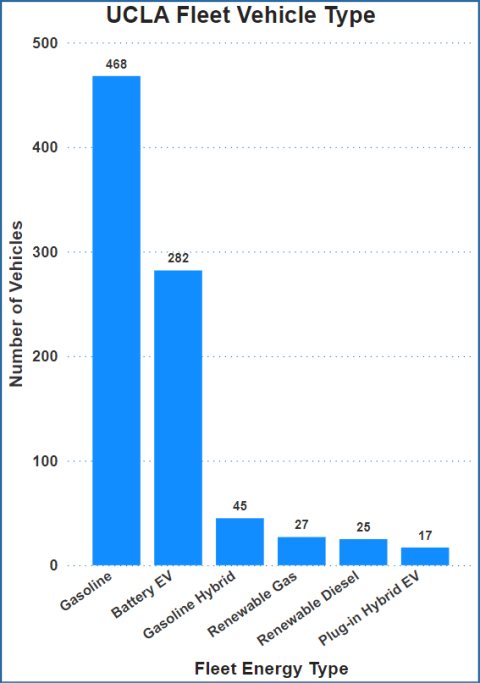Sustainable Transportation
All employees commute to work either by car, bus, bike, or walking. Commuting as a single-occupant in a gas powered vehicle contributes more to greenhouse gas emissions than any other mode of transportation. UCLA Health provides alternative transportation options to help employees get to work safely with the lowest possible impact to the environment.
Single-Occupancy Vehicle (SOV) Commute
Single-Occupancy Vehicles (SOV) is the most common form of commuting in Los Angeles, and has led to world-renown traffic congestion, long commute times, and significant air pollution and greenhouse gas emissions, which greatly impact air quality. These are privately operated vehicles in which the driver is the only occupant commuting in the car. In fiscal year 2022, 63% of UCLA Santa Monica Medical Center employees commuted to work by SOVs.
The UC Sustainable Practice Policy establishes the objective of reducing SOV commuting by 10% by 2025, and that SOV commuting should not exceed 40%. The UCLA Health team along with UCLA’s transportation team is working on developing and expanding alternative modes of transportation and commuting options for employees, in order to reduce SOV commutes and improve sustainable transportation.
The UCLA transportation team promotes access and mobility to employees in an environmentally responsible manner. Below are some alternative transportation tips and resources
Alternative Transportation
Walk
Walking provides physical and mental health benefits as well as being the most economical option. If you live within 5-15 minutes walking distance away from work, consider walking as an option. View the UCLA Transportation website to read their Safety Tips before taking to the sidewalks!
Bike
Riding a bicycle is a fun, healthy, and relatively inexpensive way to commute to work. There are over 3,500 bike parking spaces on the Westwood UCLA campus along with newly added bike lanes. The Metro Bike Share has also expanded to UCLA campus and Westwood Village. Employees are eligible for the Earn-A-Bike Program to receive a free $800 bike package in exchange for their parking permit. View the UCLA Transportation website to learn more about planning a bike commute route, securing bike parking, and discount at select local bike shops.
Public Transit
Public transit is the best option for employees commuting medium distances. Employees who commute are able to avoid the stress of traffic, reduce commute costs, and relax during their ride. UCLA transportation subsidizes eligible employees’ transit pass for select seven transit agencies: Los Angeles Metro bus and rail lines, Santa Monica Big Blue Bus, Culver CityBus, Antelope Valley Transit, Santa Clarita Transit, Long Beach Transit, and LADOT Commuter Express. Learn more about the Bruin Commuter Transit Benefit and register. Depending on where you are commuting from, there is likely a transit option for you. Visit the UCLA Transportation website to learn about subsidized transit programs and rider tips.
Carpool
Carpooling is an excellent way to reduce single-occupancy-vehicles, encourage employees to socialize, and save money. Employees can use the UCLA Transportation Trip Planner to help match employees commuting from similar areas and same working hours. Carpool groups can apply for a Staff Carpool Permit to save money, instead of paying for individual parking permits. See the UCLA Carpool Agreement for seamless cooperation between employees.

The UCLA Health Sustainable Transportation Working Group is comprised of stakeholders across the network working together to expand alternative transportation options. The working group is also responsible for meeting the sustainable transportation goals set in the UCOP Sustainable Practice Policy. The UCLA Health Sustainability team and the Sustainable Transportation Working Group are working on expanding electric vehicle (EV) charger stations, communicating telework policies, and procuring clean fleet vehicles.
Sustainable Transportation Progress
Zero Emission Vehicles (ZEV)
Zero-emission Vehicles (ZEV) are vehicles that do no emit exhaust or other pollutants from the source of power, which includes battery-electric, hydrogen fuel cell, and plug-in electric hybrid vehicles. ZEVs play an important role reducing greenhouse gas emissions and air pollution emitted via transportation. In fiscal year 2022, 10% of UCLA Santa Monica Medical Center employees commuted to work with ZEVs. The UC Sustainable Practice Policy requires 4.5% of employees to commute with ZEVs by 2025 and 30% of employees to commute with ZEVs by 2050.

Electric Vehicle (EV) Chargers
Electric Vehicles (EV) are rapidly gaining popularity in California, and rightfully so. EVs are drastically better commuting options than gasoline powered vehicles in order to combat climate change and reduce smog pollution. UCLA Transportation and UCLA Health is committed to creating infrastructure that supports employee and visitor’s choice to drive EVs by installing EV Charging stations in our parking garages.
Telework
Hybrid and remote work has proven to lead to improved work-life balance, more efficient use of time, control over work hours and work location, reduced burnout, higher productivity, and reduced environmental impact associated with vehicle emissions. The UC Sustainable Practices Policy includes a commitment that each UC location strives to have no more than 40% of its employees commuting to the location by SOV’s by 2025 – this policy goal will be partially achievable by reducing the number of non-critical in-person staff members commuting to the system. UCLA Health provides essential in-person services and for many employees and staff members, telecommuting is not an option. For certain administrative departments, telecommuting and remote work is an option and positive way to reduce your environmental impact associated with commuting emissions. Please check with your department regarding overall telework and remote work options.
Clean Fleet
The UC Sustainable Practice Policy requires locations to acquire at least 50% of all vehicles to be ZEVs. In fiscal year 2022, UCLA Health is on pace to acquire 100% ZEV fleet vehicles. Almost all of our patient transport vehicles are EV’s. See the breakdown of UCLA Transportation fleet vehicle emission types here. We will continue to work towards expansion of our electric fleet vehicles.

UCLA Santa Monica Medical Center Ridesharing and Commuter Benefits
Enroll in the SMMC Rideshare Program for Sustainable Commuting! Employees who commute utilizing alternative forms of transportation to single occupancy vehicles (including walking/biking and carpooling) a minimum of 3 times a week are eligible to join the SMMC Rideshare Program and earn up to $30 in Bruincard funds monthly.
Contact Noreima Diaz, Rideshare Coordinator, at [email protected] for more information and to enroll.
- Biking/Walking: If you live within 5-10 miles of SMMC, consider a combination of biking and walking to work – check out UCLA’s Biking page to discover benefits and discounts available to employees
-
Carpooling: Register your carpool with SMMC’s Parking and Security Services in order to receive a discounted parking permit and become eligible for monthly meal ticket benefits
Check out the UCLA Trip Planner to find and connect with other UCLA & UCLA Health employees commuting from your area
- Vanpooling: UCLA Health contracts with Enterprise to facilitate vanpooling to SMMC from two current locations:
- Palmdale 12hrs: Arrives at SMMC at 7 am and departs at 7 pm
- Santa Clarita: Arrives at SMMC at 6:30 am and departs at 2:30 pm
Reach out to UCLA Health’s Rideshare Coordinator if you’re interested in participating in an existing vanpool or starting a new vanpool
- Public Transit: Check out the Subsidized transit passes available to UCLA and UCLA Health employees, which include Santa Monica